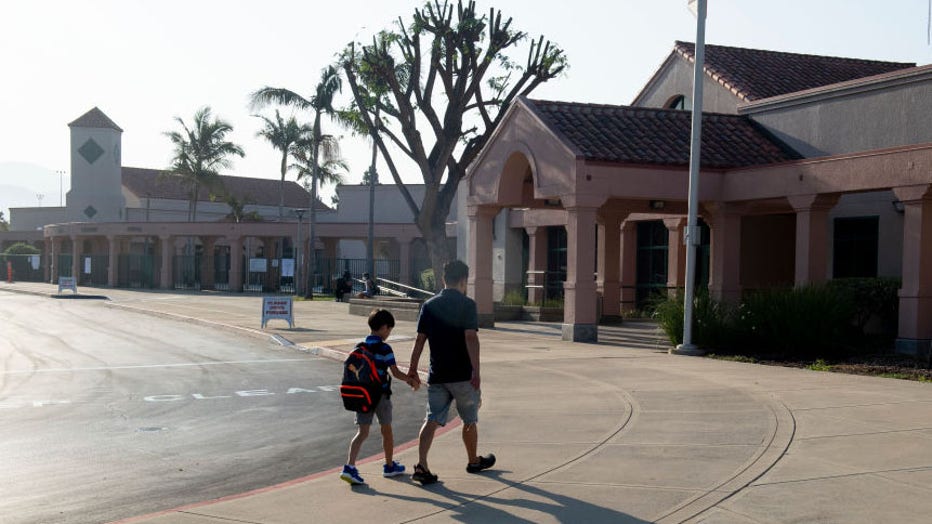How to reset your child’s sleep schedule for back-to-school
From heightened focus to forming and retaining memories, getting a good night’s rest is essential to a child’s success at school.
Sleep is one of the three pillars of a healthy lifestyle, along with proper nutrition and exercise. Students who get the recommended hours of sleep on a regular basis are more likely to have improved attention, behavior, learning, memory, emotional regulation, quality of life, and mental and physical health, according to the American Academy of Sleep Medicine.
The key to achieving proper rest is setting a bedtime — and sticking to it year-round. Experts say getting back on a regular sleep schedule for children after the summer break is important, and if needed, families can take it one day at a time.
RELATED: No more pandemic-era free lunches at most US schools this year
Here’s what to know about back-to-school sleep, creating a good bedtime routine, and more:
How many hours of sleep should kids get?
In general, children and teens need more sleep than adults. The amount of sleep a child needs can vary, based on their age and activity level. The American Academy of Sleep Medicine recommends the following:
- Infants (ages 4 months-12 months) need 12 to 16 hours (including naps)
- Toddlers (ages 1-2 years) need 11 to 14 hours (including naps)
- Preschoolers (ages 3-5) need 10 to 13 hours of sleep (including naps)
- School children (ages 6-12) need 9 to 12 hours of sleep
- Teenagers (ages 13-18) need 8 to 10 hours of sleep
But a 2018 study published by the U.S. Centers for Disease Control found that most American children and teenagers are getting less than the recommended amount of sleep.
Nearly 6 in 10 middle schoolers and at least 7 in 10 high schoolers don’t sleep enough on school nights, according to the study. Nationwide, roughly two-thirds of all U.S. high school students surveyed reported getting less than eight hours on school nights.
"Insufficient sleep among children and adolescents is associated with an increased risk for obesity, diabetes, injuries, poor mental health, attention and behavior problems, and poor academic performance," the study stated.
The American Academy of Sleep Medicine has a bedtime calculator to help identify an appropriate bedtime.

FILE - Unopened toys are seen alongside an American flag bedspread in the boys' bedroom in Alexandria, Virginia, on Feb. 1, 2017. (Photo credit: SAUL LOEB/AFP via Getty Images)
How to get back on a regular sleep schedule after summer break
Over the summer months or other holiday breaks, sleep schedules may understandably shift with events and activities. But the Sleep Foundation, a nonprofit focused on sleep education and advocacy, recommends that parents try to help their children go to bed and wake up at the same time each day "whenever possible."
"That way, even when school restarts after a break, they are already in the habit of having scheduled sleep," the nonprofit states.
But what if that didn’t happen? Sleep experts say the process of adjusting a sleep schedule should be "incremental," taking it one day at a time.
"In the weeks leading up to going back to school, have your child wake up 15 minutes earlier and go to sleep 15 minutes earlier than they have been during their break," the Sleep Foundation states. "Continue to adjust their bed and wake times in 15-minute increments every few days until your child is sleeping and waking at the desired times for school."
By the time school starts, they should be adjusted to the new sleep times.

FILE - Students were back on campus for the first day of classes at Tustin Ranch Elementary School in Tustin, CA on Aug. 11, 2021. (Photo by Paul Bersebach/MediaNews Group/Orange County Register via Getty Images)
This can be challenging for some children, though. Parents are advised to be patient, and older kids may benefit from talking about the importance of sleep and creating good habits.
"If your child does not fall asleep after twenty minutes, have them come out of their room and do a quiet, sleep-inducing activity free from blue light. When they are sleepy, help them to bed again," the Sleep Foundation states.
RELATED: Back-to-school shopping savings tips
How to create a good bedtime routine
Slowing down at the end of the day can help children sleep well and prepare for the next day of school.
Good bedtime routines include turning off televisions, tablets, handheld video game devices, computers, and phones an hour before bedtime, as multiple studies have suggested that kids exposed to blue light before bed experience poorer quality of sleep.
Instead, kids can turn to more relaxing activities, including:
- Taking a warm bath/shower
- Brushing teeth and washing up
- Cuddling with a parent
- Singing lullabies
- Reading with a parent or individually
- Journaling
The environment can also contribute to how well a person sleeps at night, according to the Sleep Foundation.
Parents should keep a child’s room dark and cool, eliminate noises when they’re trying to sleep, and use the bed for sleep only — encouraging kids to do homework or other activities elsewhere.
RELATED: Sleeping on the job? Casper is now hiring professional snoozers for cash
This story was reported from Cincinnati.


